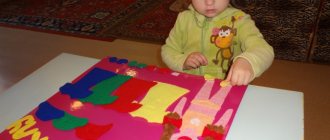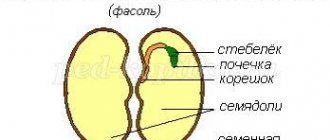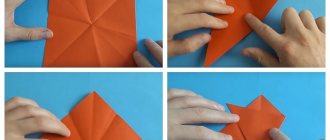Class notes
| Author's full name | Title of the abstract |
| Karpova E.V. | "Violet" (painting with watercolors and wax) Educational objectives: learn to draw a houseplant violet, improve skills in working with watercolors and wax pencils. Developmental tasks: expand your understanding of indoor plants, their medicinal properties, expand your vocabulary, develop color perception and a sense of composition. Educational tasks: maintain interest in research activities, respect for plants, and the desire to care for them. Integration of educational areas: “Artistic creativity”, “Cognition”, “Communication”, “Socialization”, “Health”. Demo material: pictures of indoor plants, audio recording of the song “Magic Flower”. Handout: sheets of white paper according to the number of children, watercolor paints, simple and wax pencils, sippy cups, brushes, brush holders. Progress of the lesson: Riddle about indoor plants. Conversation: why are they needed in the house (they decorate the interior, make the air cleaner, saturate it with oxygen and moisturize it, lift people’s spirits). The teacher tells the children that since ancient times people have valued beautiful flowers, and even held holidays in honor of flowers. The teacher asks the children what kind of indoor flowers grow in their home and who takes care of them. The teacher draws the children’s attention to the plants that are in their group and asks them to tell the children about the rules for caring for them. Preschoolers should know that plants are also living beings; they, like people and animals, breathe, grow, and drink water. In addition, they feel kindness and affection. It’s not for nothing that evil, soulless people’s flowers grow poorly, don’t bloom, and often die. A story about the medicinal plants aloe and Kalanchoe, which are also called the “house doctor.” Violet is the most picky of indoor plants; its other name is “pansy”. The teacher tells the children the ancient Greek legend of the origin of this beautiful flower: the goddess Aphrodite bathed in a grotto, where no one should have seen her. Several people were spying on her. The angry goddess turned her father Zeus to punish them - and he turned them into flowers, which with their appearance express curiosity and surprise. Violets come in different colors. The most beautiful ones have double leaves, the edge of their petals has a fringe of a contrasting color (blue ones have white, red ones have purple, white ones have blue). The teacher invites preschoolers to draw a violet in an unconventional way to get a beautiful fringe. Explanation of the sequence of the plant image. The sheet of paper is positioned vertically. The core of the flower is drawn in yellow. The fringe and pattern of the petals are drawn with a purple wax pencil, and when the petal is covered with watercolor, the wax is not painted over and remains purple - the branches look beautiful and impressive. The design is complemented by green violet leaves, and the children choose the shape, color and decoration of the pot themselves. Before the children’s independent activities, a physical education session “Flowers grow in the meadow” is held.
|
| Ptashinskaya N. | “Houseplant” (Drawing from life) At the beginning of the lesson, the teacher reads to the children V. Viktorov’s poem “Flower” (about how a man picked a flower, it stood in a glass for a day and withered). Next, a conversation begins about indoor plants, the children name them and tell what conditions they need to live. Word game "What if?" Children answer the teacher’s questions regarding indoor plants (for example, what if you don’t water the flowers? Etc.). Then the teacher invites the children to turn into real artists who draw objects from life (motivation). Today these will be indoor plants - sansevieria and chlorophytum (optional). The features of their appearance are discussed. After the children have completed their work, the teacher gives them homework - to check if they have poisonous plants at home (ficus, spurge, etc.). |
| Zamalieva E.F., Minnullina A.R., Sorokina A.F., Tukhvatullina L.K. | "Houseplants for a fairy" The lesson begins with a surprise moment - a package is brought to the group. To find out what's in it, children must solve riddles:
The teacher opens the box - it contains a photograph of an unknown indoor plant (there is a question mark on the pot). Next to him is a toy fairy. It turns out that she had previously lived in a store where there were no indoor plants, and she had never seen them. The fairy doesn’t know at all how to care for them and asks to be taught how to do it. Pictures depicting garden and indoor flowers are shown. A mini-conversation about indoor plants is held. A corner of nature is considered. The guys tell the fairy how to care for plants. The teacher draws the children's attention to a chlorophytum sprout that has taken root in a glass of water. This flower purifies the air, and the teacher invites preschoolers to give the fairy a lot of chlorophytums so that she always has clean air in her house (motivation). Techniques for depicting plants are demonstrated. A physical education session on a flower theme is being held. Children begin independent activities. At the end of the lesson, the fairy thanks the guys and tells them that it turns out that the parcel contained a photograph of chlorophytum. |
| Kolesnik T.V. | “Cosmea” The lesson begins with a conversation about autumn. Children recite previously learned poems about this time of year. A surprise moment: summer has not yet completely left and sent the children a gift that is in a box. To find out what it is, the guys guess a riddle (about flowers). The box contains a vase with calendula and petunia flowers. The teacher shows the children an image of another flower - cosmos. The children repeat its name in chorus. It turns out that this plant can live both outdoors, in a flower bed, and indoors, in a pot. Preschoolers are invited to draw this beautiful plant. The teacher demonstrates drawing techniques: petals are drawn using the dipping method, and the stem and leaves are drawn with the tip of a brush. Children draw cosmos to the composition of P. Tchaikovsky “Waltz of the Flowers”. |
Lesson Objectives
This lesson has three main objectives:
- educational;
- educational;
- developing.
Note! During the GCD, children should gain new knowledge about why plants are grown at home and what care they require.
Independent learning of English with children from scratch
It is also the responsibility of the teacher to explain why it is important to take care of flowers.
By drawing flowers, children will be able to:
- practice drawing straight lines without a ruler;
- learn not to go beyond the outline when coloring;
- mix several shades of the same color.
Practical part of the lesson
After a brief introduction to the theory, students should begin drawing. The plant is a great way to learn how to draw long straight lines without a ruler, mix different shades of green, adding yellow, blue or brown to the paint, layouts on a sheet (the drawing should be large enough, located in the center).
Drawing classes for children 2-3 years old - teaching the baby
Suitable techniques for drawing in the senior group:
- pointillism - drawing with dots, suitable for watercolors;
- “wet on wet” watercolor is suitable for painting large areas (background, leaves, pot);
- gouache, but you need to explain how to mix colors to convey shadow and light;
- colour pencils. Attention should be paid to the contour beyond which you must not go.
Example of step-by-step drawing of flowers
To create a creative atmosphere, you can turn on music. It should be a calm melody without words so that it does not distract the children. It is worth considering that a song that is too cheerful and fast will undermine the calm.
Important! The musical accompaniment should not be too loud so as not to cause discomfort.
How should drawing “Indoor Plants” proceed step by step (senior group of kindergarten):
- Organize your workplace.
- Make a composition on a sheet of paper. Mark the location of the inflorescence in a circle in the center, the stems with lines, and the leaves with ovals.
- Draw an outline with a simple pencil.
- Explain the features of the technique chosen for drawing.
- Paint over in stages: first the background, then the light areas of the flower, then the dark ones.
- Dry the drawing.
- Use a brush with a minimum of water to draw details (veins in leaves, highlights).
Works of the children from the senior group





